In today’s increasingly interconnected world, organizations in the healthcare industry need to rely on various third parties to deliver essential services, facilitate seamless processes, and support cost-effective operations. However, such collaborations come with their own unique risks and challenges. As a result, it has become increasingly critical for healthcare organizations to establish robust third-party risk management programs. In this article, we will explore some of the best practices that can help healthcare organizations design and implement a successful third-party risk management program.
1. Setting Clear Objectives and Scope
To begin with, it is important to establish clear objectives and define the scope of the third-party risk management program. Doing so will ensure that all stakeholders are on the same page and that the program is aligned with the organization’s larger risk management and compliance efforts. When setting objectives, consider aspects like types of risks, regulatory requirements, and industry best practices that apply to the organization.
2. Utilizing Effective Third-Party Risk Management Software
One of the best ways to streamline and enhance the accuracy of the third-party risk assessment process is to adopt third party risk management software. By automating workflows, documentation, and tracking, such software solutions enable organizations to consistently identify, assess, and monitor third-party risks. Furthermore, these software platforms can facilitate cross-functional collaboration and help organizations stay agile as they address emerging risks and changing regulations.
3. Establishing a Centralized Repository
Another best practice in managing third-party risks is to establish a centralized repository for all documentation, policies, and data related to third-party engagements. This can help ensure quick access to information in case of audits or evaluations and support monitoring and compliance with relevant regulations. A centralized repository can also aid in risk analysis efforts, enabling organizations to better understand trends and patterns in their third-party ecosystem.
4. Conducting Regular Third-Party Risk Assessments
Effective third-party risk management necessitates regular, ongoing risk assessments to track the concerns and performance of vendors and other third parties. By conducting such assessments consistently and at regular intervals, organizations can stay aware of any changes in the risk landscape and adapt their risk management efforts accordingly. These assessments should be objective, data-driven, and aligned with the organization’s predefined risk criteria.
5. Enhancing Third-Party Risk Awareness and Education
For a third-party risk management program to be truly effective, it is essential to foster a culture of risk awareness throughout the organization. This can be achieved through regular training sessions, educational resources, and communication channels to keep employees informed about relevant risks and their roles in managing them. A well-informed staff can be a valuable asset in identifying concerns or risks before they escalate into significant issues.
6. Continuous Improvement and Adaptation
Lastly, it is important to recognize that the risk landscape is constantly changing, and organizations must continually improve their processes, policies, and technologies to keep up. Regularly reviewing and refining the third-party risk management program can help identify emerging risks, ensure compliance with evolving regulations, and drive continuous improvement.
To Wrap Up
The implementation of a successful third-party risk management program requires a clear understanding of the organization’s risk profile, the adoption of appropriate technologies and methodologies, and a culture of awareness and ongoing adaptation. By applying the best practices outlined in this article, healthcare organizations can better manage third-party risks and ensure a more secure and compliant future.

